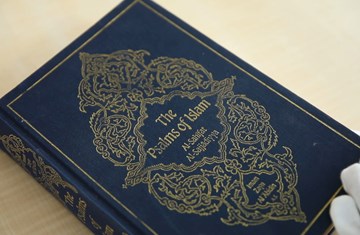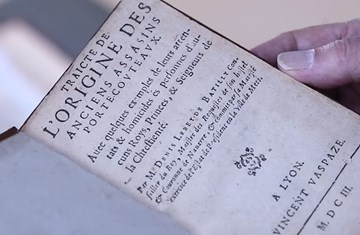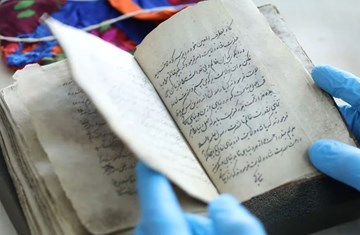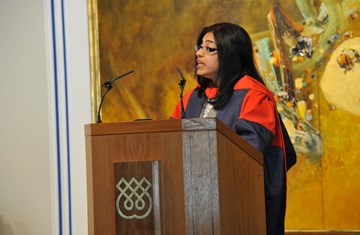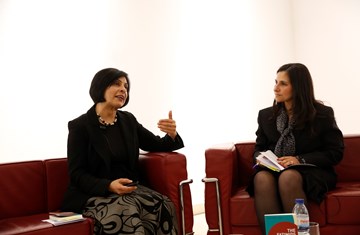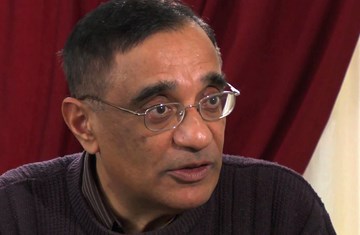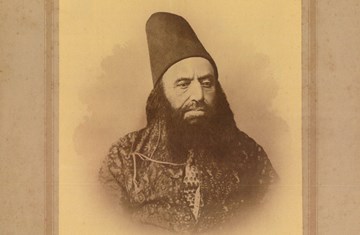Ismaili-Sufi Interactions in Badakhshan Manuscripts
This short film features Dr Orkhan Mir-Kasimov, an Associate Professor at the Institute of Ismaili Studies, exploring Ni‘matullāhī works transmitted in Badakhshan Ismaili manuscripts which shed light on Ismaili-Sufi interactions as evident from these manuscripts.

Ismaili Special Collections: Islamic Heritage Past and Present - Ismaili-Sufi Interactions in Badakhshan Manuscripts
This second episode forms part of a new series from the Ismaili Special Collections Unit (ISCU) and the Department of Communications and Development (DCD). The series will showcase items of historical importance held at The Institute of Ismaili Studies, and highlight their contemporary relevance today.
I'm Orkhan Mir-Kasimov, Associate Professor at The Institute of Ismaili Studies.
When I started working on the Ni‘matullāhī manuscripts coming from the private Ismaili collections in Badakhshan, one of my central questions was to understand why these works, mostly attributed to the prominent Sufi master of the 15th century, Shāh Ni‘matullāh-i Walī, were preserved and apparently copied and circulated until the present time within the Ismaili community. Of course, we know that the Ismailis and Ni‘matullāhīs entertained close and friendly relationships, especially between the 18th and the middle of the 20th centuries. However, my feeling was that the contents and circulation of the manuscripts indicate some deeper reason which cannot be reduced to historical and political circumstances alone.
Equally unconvincing is the idea that the Ni‘matullāhī manuscripts are used for the purpose of the “tactical dissimulation” (taqiyya). This is because the modern Ismailis are not hiding their identity, and even if they were concerned by the taqiyya it is difficult to see how the random recitation of the Sufi poetry could serve such an objective.
The way the Ni‘matullāhī manuscripts are incorporated into the Ismaili cultural heritage and ritual suggests that these works were considered as a part of this heritage. In other words, Shāh Ni‘matullāh-i Walī, like other prominent Persian-speaking mystical poets and thinkers such as Sanā’ī Ghaznavī , Farīd al-Dīn ‘Aṭṭār, and Jalāl al-Dīn Rūmī, were harmoniously blended into the cultural and intellectual identity of the Ismaili community of Badakhshan. And this can be considered as a particular case of a much broader interaction and rapprochement between Shi‘ism and Sufism which was present throughout the Islamic history but significantly accelerated in the period following the Mongol invasions of the 13th century.
At this point, I would like to highlight that we sometimes tend to think about various Islamic groups and movements in clear-cut categories. Here we have Sunnis, and here we have Shi‘is. On the one side we have Sufis, on the other we have jurists (ulama). We have rationalist theology (kalam) on the left, and we have traditionalists on the right. From this perspective, for example, the Shi‘is in general and Ismailis in particular are a group distinctly different from the Sufis. However, in reality we often have situations when the borders delineating these identities are more porous. For example, there is something that some scholars call “Sunni-Shi‘ism”, when Sunni authors praise ‘Ali b. Abū Ṭālib and Shi‘i Imams. There exist Shi‘i-Sufi orders. And perhaps the Ismaili appropriation of Ni‘matullāhī texts can be considered from the point of view of this phenomenon of “combined” or “fluid” identities. In other words, this means that we should try to understand the real identity of various groups not trying to insert them into one of the existing categories.
Now to return to the interactions between the Sufis and Shi‘is. Sufis and Shi‘is are two esoteric currents of Islam and, as such, they share many common features. Major branches of the Shi‘is, such as the Twelvers and the Ismailis, adhere, like the Sufis, to the idea of divinely inspired guide. However, for the Sufis the spiritual leadership is not limited to the prophetic family and belongs to the Shaykhs, spiritual masters who attained the highest degree of enlightenment. Both Sufis and Shi‘is venerate ‘Alī b. Abū Ṭālib and the prophetic family and recognise the divine election (walāya) as source of spiritual knowledge. The impregnation of the Shi‘ism by Sufi ideas and symbolism was, to some extent, a compensation for the weakening of the esoteric aspect of the Twelver Shi‘ism after the occultation of the 12th Imam, and for the difficulty of the direct expression of the Ismaili doctrinal views after the destruction of Alamut.
Another strong argument for the incorporation of the Sufi literature into the Nizārī Ismaili tradition is that the Nizārī written heritage was severely diminished after the destruction of the libraries in Ismaili strongholds in northern Iran. Recognition of the Sufi literature as expressing the same esoteric truths as the teachings of the Imams could have been seen as a remedy to the loss of the Ismaili libraries in the fire of Mongol invasions. Such as the background against which not only the historical, but also deeper spiritual and intellectual bonds between the Ismailis and Sufis should be
considered.
The compilations of poetry attributed to Shāh Ni‘matullāh-i Walī in the holdings of the Ismaili Special Collections include mostly manuscripts dating from the 19th and 20th centuries. Significant amount of manuscripts are written on modern supports and this shows that this poetry is still popular and circulates widely among the Ismailis of Badakhshan. A few notes about the contents of these fragments of poetry. The selection of the poems attributed to Shāh Ni‘matullāh-i Walī clearly resounds with Ismaili worldview. For example, Shāh Ni‘matullāh-i Walī calls himself the light of ‘Ali (nūr-i ‘Alī). He is the sun of the Real (ḥaqq) and the Real itself (man shams-i ḥaqīqatam ke ḥaqqam). He is the teacher of the prophetic law, and he is the guide in the paths of sainthood (walāya). He is the mirror reflecting the walāya of ‘Alī b. Abū Ṭālib. Several manuscripts contain verses praising ‘Ali and his family, describing ‘Ali as the supreme Imam etc.
In addition to the poetry, one manuscript (dating from 19th century) contains also a substantial collection of Shāh Ni‘matullāh-i Walī's doctrinal works, more details on this can be found in my article in the volume Texts, Scribes and Transmission edited by Dr Wafi Momin.
As mentioned, a significant part of the poetry attributed to Shāh Ni‘matullāh-i Walī is found in manuscripts which were copied recently, that is, dating from the 20th century. This would suggest an active circulation of these texts in modern Ismaili community of Badakhshan. It can be supposed that these manuscripts were used as memory aids in rituals and practices such as Chirāgh-i rawshan and maddāḥ-khānī.
Shāh Ni‘matullāh-i Walī is still referred to by some Ismailis in Badakhshan as pīr-i ma‘rifat (‘master of knowledge’, ultimate teacher). However, it seems that the younger generation is less familiar with the Arabic script and might have their copies now transcribed in Cyrillic, and the knowledge of any doctrinal aspects incorporated into Shāh Ni‘matullāh-i's poetry has apparently decreased.
To conclude, I would like to say that while the study of the Ismaili manuscripts obviously is our main source of knowledge on the Ismaili tradition itself, the study of the non-Ismaili manuscripts preserved in Ismaili collections gives us an insight into the relationships between the Ismailis and other Islamic groups. So it appears that in spite of its obvious relevance to the area of Ismaili and broader Shi‘i and Islamic studies, this topic has not been systematically explored yet. A more substantial exploration of the non-Ismaili manuscripts circulating in Ismaili milieus would therefore be highly desirable.


